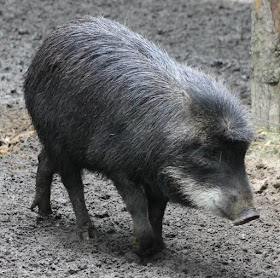 |
| Wild Pig |
If the Jaredites brought Old World species of swine to the land of promise no archaeological evidence for this has be identified thus far. Some readers of the Book of Mormon have suggested that Old World migrants applied the term swine or its equivalent to other species they found upon their arrival. One very good candidate for the swine mentioned in the Book of Mormon is the American peccary.
 |
| Wild Pigs (Texas) These are descended from pigs introduced in Post-Columbian times |
 |
| Collared Peccary or Javelina (Saltillo Mexico) |
Recently, some critics of the Book of Mormon have scoffed at the idea that migrants from the Old World to the new may have applied names they were familiar with new animals they encountered. Such criticisms are uninformed.
Shift happens.
Peccaries are not true pigs in terms of modern scientific classification, but they resemble them greatly in both appearance and behavior. The Spanish Conquistadors, explorers, and historians considered them pigs. Lyle Sowls observed:
When one travels within range of the peccaries, one hears references to “wild pigs” or “wild hogs.” In Spanish-speaking countries these are “los puercos,” “los cerdos,” or “los cochinos,” while in Portuguese-speaking countries the country people talk of “porcos.” German settlers in South America refer to “the schwein.” All of these names have been given to peccaries by people who first knew domestic hogs and equated them with peccaries in the New World (The Peccaries. Tuscon: University of Arizona Press, 1984, 1).
 |
| Collared Peccary or Javelina (Saltillo Mexico) |
Two known species of peccary that can be found throughout Central, and South America are the white lipped peccary and the smaller javelina or white-collared variety. Both of these species are at home in the tropical regions of the Tuxtlas Mountains of Mexico which some Latter-day Saints have suggested may have once been inhabited by the Jaredites. In his abridgment of the Jaredite record Moroni refers to "all manner of . . . swine" (Ether 9:18) suggesting that for the Jaredites at least there may have been more than one kind.
 |
| Collared Peccary or Javelina (Saltillo Mexico) |
 |
| White-lipped Peccary |
The collared peccary is known to live in herds of up to 20--30 animals. It has "characteristically hog-like jowls, protruding snout, thick neck, and delicate skinny legs. Gray to black hair covers its heavy-set body, with longer stiffer hairs cresting the spine. A collar of pale hair rings the neck. Like pigs, it grunts, or when frightened makes a doggish bark . . . They roll in the mud or dust to cool and clean off (Victoria Schlesinger, Animals and Plants of the Ancient Maya: A Guide. Austin: University of Texas Press, 2001, 157-58).
One interesting characteristic of the peccary is the pungent musk gland it has on its back. This enables it to emit an unpleasant odor when provoked. Once killed, it is necessary to remove this glad from the carcass or the musk will render the meat inedible. If this is done, however, the problem is is eliminated
In spite of their gentle appearance, wild javelinas can be fierce when they feel threatened or cornered. One observer in northern Mexico observed, "Many dogs are killed by Peccaries, being torn open or gashed by their long, sharp-edged canine teeth. When about to attack, the Peccary lowers its head, champs its teeth, and advances sideways with its mouth open and under jaw turned to one side, ready for an upward lunge to rip up its enemy" (A. Starker Leopold, Wildlife of Mexico. Berkeley and Los Angeles: University of California Press, 1959, 497). One thinks of the Savior's words "lest they turn again and rend you"!
 |
| White-lipped Peccary |
The White-lipped peccary behaves much like the Collared Peccary, but favors swampy regions with thick vegetation. "This animal is more gregarious than the collared peccary, and hundreds of individuals may travel or wallow together; when this occurs, the low rumbling noise made can be heard for almost a kilometer" (Brian D. Dillon, "Meatless Maya? Ethnoarchaeological Implications for Ancient Subsistence," Journal of New World Archaeology 7 [1988]: 63). Both species are also omnivorous like domestic hogs.

No comments:
Post a Comment
Note: Only a member of this blog may post a comment.